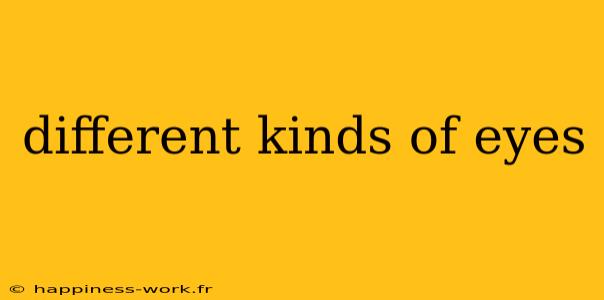Eyes are fascinating organs that come in various shapes, sizes, and colors. They not only serve the primary purpose of vision but also express emotions and enhance beauty. In this article, we will delve into the different kinds of eyes, their characteristics, and their significance in both humans and animals.
1. Types of Human Eyes
Humans possess a diverse range of eye colors and shapes. Let’s explore some of the most common types:
A. Eye Colors
-
Brown Eyes
Brown is the most common eye color worldwide. The high melanin content in the iris gives them their rich, dark hue. People with brown eyes are often perceived as trustworthy and warm. -
Blue Eyes
Blue eyes result from a lack of melanin, leading to their striking appearance. Interestingly, blue eyes are more common in people of European descent and have been linked to genetic mutations that arose thousands of years ago. -
Green Eyes
Green eyes are among the rarest globally, resulting from a combination of low melanin levels and the presence of yellow pigment. People with green eyes are often perceived as mysterious and captivating. -
Hazel Eyes
Hazel eyes are a blend of brown and green shades, with flecks of gold or amber. This unique color can appear to change depending on the lighting and the person’s clothing. -
Gray Eyes
Gray eyes are less common and can sometimes appear blue or green under certain conditions. They are often considered enigmatic and possess a striking beauty.
B. Eye Shapes
-
Almond-Shaped Eyes
Almond-shaped eyes are characterized by their elongated form and pointed corners, resembling an almond nut. This eye shape is often associated with beauty and is common across various ethnicities. -
Round Eyes
Round eyes are larger and more open than almond-shaped eyes. They convey a sense of innocence and are often associated with youthfulness. -
Monolid Eyes
Common in East Asian populations, monolid eyes lack a prominent crease, giving them a smooth appearance. This eye shape can be accentuated with makeup techniques. -
Hooded Eyes
Hooded eyes have a fold of skin that partially covers the eyelid, creating a "hooded" look. This can be seen as sultry and can be beautifully styled with the right makeup.
2. Animal Eyes: A World of Diversity
Eyes in the animal kingdom vary greatly and serve different functions that are vital for survival. Here are a few remarkable examples:
A. Cats
Cats have slitted pupils that allow for precise control over the amount of light entering their eyes, making them exceptional hunters in low light. Their night vision is far superior to that of humans.
B. Frogs
Frogs have bulging eyes that allow for a wide field of vision, enabling them to spot predators and prey from nearly all angles. Additionally, the color of their eyes can change based on their environment.
C. Birds
Birds possess some of the most complex eyes in the animal kingdom. Many species have excellent color vision and can see ultraviolet light, which is invisible to humans. This ability aids them in finding food and mates.
D. Chameleons
Chameleons can move their eyes independently, providing them with a 360-degree field of vision. This adaptation helps them spot predators while hunting for insects.
3. Cultural and Symbolic Significance of Eyes
A. In Art and Literature
Throughout history, eyes have been a symbol of knowledge, understanding, and enlightenment. Many famous works of art depict eyes as a reflection of the soul, while literature often uses eye color and shape to convey character traits and emotions.
B. In Psychology
Psychologically, eyes play a significant role in human interaction. Eye contact is essential for communication, conveying confidence and trustworthiness. Additionally, studies show that people tend to judge others based on their eye color and shape.
Conclusion
Understanding the different types of eyes enhances our appreciation for both human diversity and the animal kingdom’s adaptability. From the rare beauty of green eyes to the astonishing function of cat’s pupils, eyes are truly remarkable. Whether they express emotion, reflect personality, or serve practical purposes in the animal world, eyes are a fascinating subject deserving of exploration.
Additional Resources
If you're interested in learning more about eye care and health, consider checking reputable sources like the American Academy of Ophthalmology or speak to an eye care professional.
By exploring the different types of eyes, their significance, and their roles in nature and culture, we can celebrate the diversity of vision that enriches our world. Whether you're drawn to their beauty, functionality, or symbolism, eyes offer a lens through which to understand ourselves and the creatures we share our planet with.
This article was inspired by various resources, including information from WikiHow, with proper attribution to their original authors.
